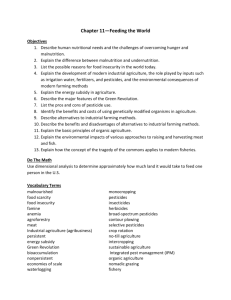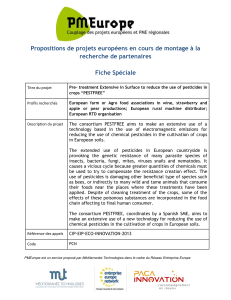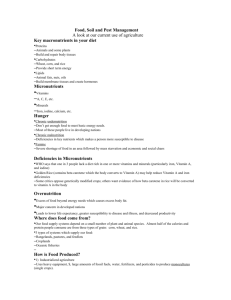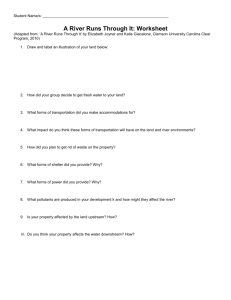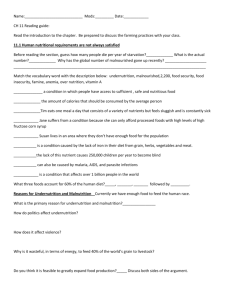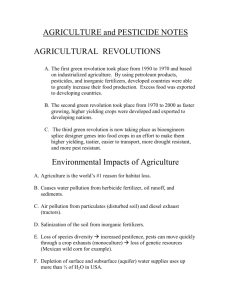ch. 18-food and agriculture
advertisement
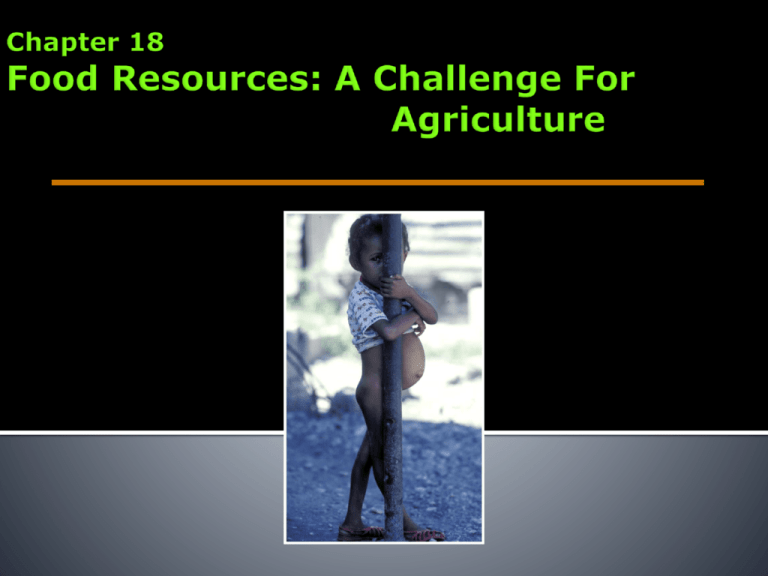
Food and Nutrition World Food Problems Principle Types of Agriculture Challenges of Producing More Crops and Livestock Environmental Impact of Agriculture Solutions to Agricultural Problems Fisheries of the World Carbohydrates Sugars and starches metabolized by cellular respiration to produce energy Proteins Large, complex molecules composed of amino acids that perform critical roles in body. Must get essential amino acids from food. Lipids Include fats and oils and are metabolized by cellular respiration to produce energy. Most energy. Vitamins (molecule) and Minerals (elements – iron, calcium) Annual grain production (left) has increased since 1970 Grain per person has not (right) South Asia and Sub-Saharan Africa Growing population Rising temperatures Falling water tables and droughts Ethanol production More grain is going towards feeding livestock. ▪ Ex: 1 kg of beef requires 7 kg grain VEGETARIANS More sustainable land use Harder to get essential amino acids Rice and beans = nutritious Just rice = not nutritious NON-VEGETARIANS Easy source of protein – meat, milk, eggs Livestock requires more land, more energy, more water Risk of heart disease Poverty and Food 1.3 billion people are so poor they cannot afford proper nutrition Undernourished vs. malnourished ▪ Kwashiokor – protein deficient More common in ▪ Rural than urban areas ▪ Infants, children and the elderly Economics and Politics Cost money to store, produce, transport and distribute food Getting food to those who need it is political Industrialized agriculture High-input High yields Fossil fuels: machinery, inorganic fertilizers, pesticides, irrigation HDC Subsistence Agriculture Low yields (enough for family) Energy from humans/work animals Require lots of land Examples: Shifting cultivation Slash and burn agriculture (deforestation) Nomadic herding No pesticides, synthetic fertilizers genetically modified crops Domestication causes a loss of genetic diversity ▪ Farmer selects and propagates plants/animals with desirable agricultural characteristics • Many high yielding crops are genetically uniform • High likelihood that bacteria, fungi, viruses, etc. will attack and destroy entire crop Increasing Crop Yield • Graph = wheat Developed countries: • fertilizers • Pesticides • Selective breeding 1960s – more grain (wheat/rice) per acre Selective breeding Use of fertilizers and irrigation made it possible to grow crops in more places Started in Mexico, spread to US, India, China Problems: High energy costs ▪ Require fossil fuels to make fertilizers, build/run tractors, construct dams/canals, pump water from groundwater Environmental degradation due to inorganic fertilizers and pesticides Led to overpopulation 4– 3– 21- CAFOs (concentrated animal feeding operations): less land, but more antibiotics. Waste disposal Increasing Livestock Yields: Antibiotics ▪ Problems with increased bacteria resistance (evolution) Hormone supplements (rBGH) ▪ US and Canada do this: increase growth and milk production. ▪ Europe does not citing human health concerns (Precautionary Principle) High use of fossil fuels Air pollution Untreated animal wastes and agricultural chemicals Water pollution Harms fisheries Insects, weeds, and disease-causing organisms developing resistance to pesticides Contaminate food supply Kills beneficial soil organisms Land degradation Decreases future ability of land to support crops or livestock ▪ Erosion – decreases soil fertility, sediments pollute water ▪ Compacting soil, waterlogging, salinization Habitat fragmentation, deforestation habitat loss erosion Decreases biodiversity and gene pool Cultivating marginal lands Irrigating dry land Cultivating land prone to erosion Water consumption Ex: Ogallala Aquifer = nonrenewable resource b/c water so old Drip irrigation! Examples: Pest control: natural Predator-prey relationships instead of pesticides, crop selection Reduce erosion: conservation tillage and contour plowing Reduce fertilizers – crop rotation, animal manure, supplying nitrogen with legumes Integrated Pest Management (IPM) Limited use of pesticides by using knowledge of the life cycles of pests, pheromones, trapping, and then targeted pesticide use; allowing some pests is fine Organic agriculture No pesticides, synthetic fertilizers genetically modified crops 4 – I can cite at least 2 methods for each of the farming issues below 3 – I can cite at least 1 method to farm sustainably for each of the following farming issues: pesticides, synthetic fertilizers, erosion, soil salinization, water consumption 2 - I know a few examples, but not one for each issue. 1 – I know what sustainable means. Transferring genes of desirable trains from one organism into the DNA of another Faster than selective breeding 1st GM food on market – Flavr Savr Tomato Typical goals Increase nutrition – ex: golden rice Pest resistance – ex: Bt corn Resistant to other environmental stress – drought, salty or acidic soils GE in animals Create hormones to increase growth Determined safe by FDA Concerns: allergies, reduced biodiversity if introduced to wild Labeling: none in US 4 – I can explain the pros and cons of GE food. 3 – I understand multiple reasons why GE food is developed AND multiple reasons why people are concerned about it. 2 - I understand either why GE food is developed or why people are concerned about it, but not both. 1 – I know what GE food is. No nation lays claim to open ocean susceptible to overuse Tragedy of the Commons Overharvesting Many species are at point of severe depletion Food for growing human population Technological advances in fishing gear Longlines – thousands of hooks Purse-sein nets Trawl net – dragged along the bottom Spotter airplanes • Overfishing reduces gene pool of existing fish • By-catch DIE Magnuson-Stevens Fishery Conservation and Management Act ▪ EX: Set quotas, limits # of boats • Marine Mammal Protection Act Ocean Pollution - dumping ground Oil Heavy metals Deliberate litter dumping Stormwater runoff from cities and agricultural areas – biggest pollution source Coastal areas degraded by development (many fish depend on tidal marshes, mangrove swamps, estuaries for spawning and feeding) Raising of aquatic organisms for human food Protein!! Negatives: ▪ Locations of fisheries may hurt natural habitats – compete for shore space, destroy mangroves, destroy breeding grounds for fish ▪ Produce waste that pollutes adjacent water ▪ Often fed fish from the wild ▪ Expensive facility ▪ Easy spread of disease antibiotics 4 – I can teach the next class. 3 – I understand at least 2 fishing techniques that may lead to overfishing, the laws that serve to protect fisheries, and the pros and cons of aquaculture. 2 – I understand but need to re-read my notes. 1 – I know why overfishing is bad.
